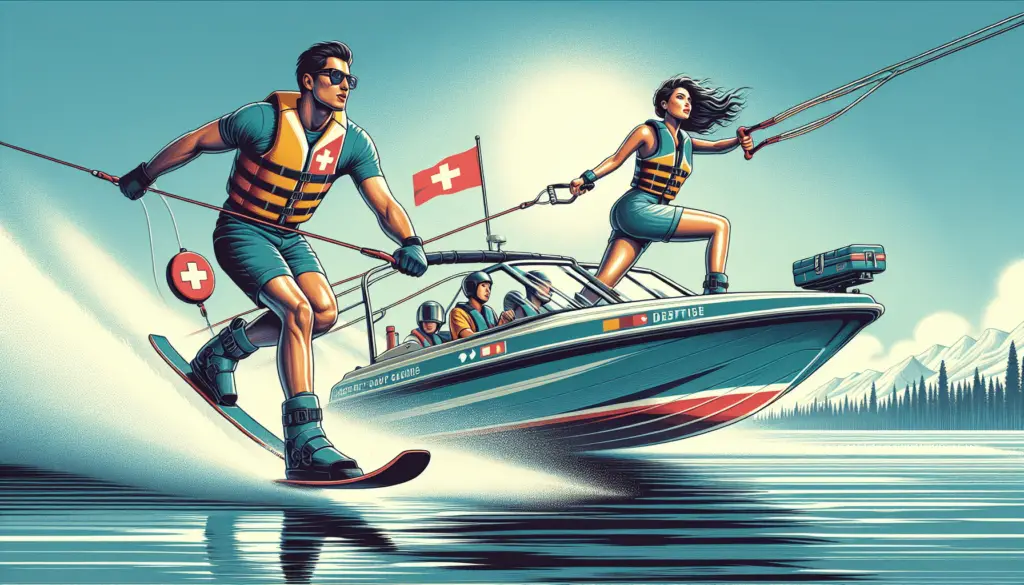Imagine the gentle sway of the boat beneath you, the sunlight glinting on the rippling water and the inescapable rush of excitement as you get ready to water ski. The thrilling landscape of the fluid world that is water skiing opens up in front of you, exuding a call to adventure. Yet, there runs a powerful undercurrent beneath all this allure, the vital gears of safety and precautions. “Boating Safety Considerations for Water Skiers” will serve as your guiding compass, helping navigate the choppy waters of potential challenges and risks, while fortifying your journey with essential measures to make it safe, secure and absolutely enjoyable. It’s not just about the thrill of the ride, it’s about the responsible navigation of the adventure.
Understanding the Basics of Water Skiing
Water skiing is a thrilling adventure sport that thrives on speed, balance, and agility. As with any sport, learning its fundamentals is crucial before you brave the waves.
The Importance of Learning Basic Water Skiing Techniques
Delving into water skiing without a solid foundation is like stepping on a dance floor with two left feet. Without knowing how to position your body, how much pressure to apply on the tow rope, or how to use your feet as rudders, you will struggle to keep your balance. Understanding basics, from getting up out of the water to adjusting your skiing speed, is invaluable in cultivating the confidence, technique, and skill needed to enjoy this unique water sport.
Understanding the Rules and Regulations of Water Skiing
Every game has its rules, and water skiing is no different. As a water skier, you must respect certain boundaries and follow specific protocols to ensure your safety and that of others. These rules include skiing at permissible times of the day, sticking to prescribed skiing zones, having a spotter on the boat, and adhering to speed limits. Understanding and abiding by these regulations minimizes risks and enriches your overall water skiing experience.
Recognizing the Potential Dangers Inherent in Water Skiing
Water skiing is a physically demanding sport that involves high speeds and challenging water conditions. It requires meticulous attention to detail as neglecting safety measures can lead to serious accidents. Recognizing potential dangers such as obstacles in the water, chances of losing control at high speeds, or the possibility of other watercraft not seeing you, can prepare you to respond effectively, enhancing your safety and well-being.
Choosing the Right Equipment
With water skiing, the right gear can be the difference between a delightful glide across the water and a clumsy struggle against it.
The Role of Skis, Life Jackets, and Safety Gear in Water Skiing
Skis are your primary tool in this sport, allowing you to skid across the water surface. Choosing the right pair is crucial for your stability, control, and speed. Life jackets are an essential piece of safety equipment, acting as your lifesaver in the water. They maintain your buoyancy and increase your visibility, making you easier to spot. Other safety gear includes a ski rope, handle, and gloves, all of which contribute to a safer and more comfortable skiing experience.
Selecting Skis According to Skill Level and Water Conditions
The type of skis you choose directly impacts your skiing performance. If you are a beginner, wider skis will provide more stability. Advanced skiers might go for narrow, flexible skis that allow for greater maneuverability. Also, consider the water conditions. If you’re skiing on a calm lake, you could choose different skis versus when you’re in rough sea conditions.
Recognizing When Gear Requires Maintenance or Replacement
Maintaining your skiing equipment is as important as having the right gear. Over time equipment can wear down, reducing its efficacy and safety. Look for signs of wear and tear, such as frayed ropes, cracks in the skis, or a loose life jacket. Regular maintenance can prolong equipment life, but knowing when to replace it is critical for your safety.

Checking Weather Conditions
Weather plays a significant role in water skiing. Understanding its influence can prevent potential mishaps.
The Impact of Weather on Water Skiing Safety
A sunny day with a gentle breeze may offer ideal conditions for water skiing. However, heavy winds, thunderstorms, or dense fog dramatically increase the risk. Rough waters can destabilize you, and visibility issues may hinder the boat operator’s ability to steer clear of obstacles.
Sources for Accurate Weather Forecasts
Reliable weather forecasts can help you plan a safe and enjoyable water skiing expedition. There are numerous sources for weather predictions, including meteorological websites, news channels, and mobile applications. Analyzing these can provide valuable insights into upcoming weather patterns.
Adjusting Plans Based on Changing Weather Conditions
The weather can change unexpectedly, and having a flexible plan is essential to handle these fluctuations. If the forecast predicts unfavorable weather, it’s best to delay or relocate your skiing trip. Always prioritize safety over the thrill of the sport.
Boat Operation and Navigation
The driver’s role in water skiing is as essential as the skier. Understanding boat controls and navigation systems can ensure a safe ride for everyone involved.
Understanding Boat Controls and Navigation Basics
Operating a boat requires knowledge of its controls, from throttle management to steering maneuvers. You need to understand how changes in speed or direction affect the skier. Additionally, navigation basics such as reading marine maps and GPS systems are crucial in unfamiliar waters.
The Importance of Maintaining a Safe Distance from Other Boats and Obstacles
The water can be unpredictable, and maintaining a safe distance from other boats, bathers, and stationary objects is critical. It prevents collisions and allows ample space for the skier to maneuver without facing abrupt obstacles.
Handling Situations Such as Skier Falls and Boat Malfunctions
Emergencies can occur despite preparedness. Whether it’s a skier falling or a boat engine stalling, you should know how to handle these situations. Having a plan for such incidents can minimize panic, thereby ensuring a swift and successful recovery.

Communicating with the Skier
Effective communication between the boat driver and the skier is a key aspect of successful water skiing.
Establishing Clear Communication Signals Between Boat Operator and Skier
Ensure that you’re familiar with standard skiing signals such as speeding up, slowing down, stop, and emergency. These non-verbal cues allow skiers to communicate their needs clearly and effectively with the boat operator.
Effective Methods for Communicating Over Distances and Through Noise
Given the distance between the boat and the skier, along with the noise of the boat engine and the water, communication can be challenging. Hand signals, whistle blows, or colored flags can serve as effective communication methods.
Watching for Other Boaters
Being mindful of other boaters and remembering basic boating etiquette can ensure a safe skiing experience for everyone on the water.
Strategies for Maintaining Situational Awareness
Situational awareness on the water means understanding your surroundings, the actions of others, and forecasting potential risks. Regularly scanning the environment and being conscious of other watercraft movement can prevent accidents.
Rights of Way and Common Boating Etiquette
Whenever multiple watercraft share the same space, respecting the “Right of Way” and following common boating etiquette is instrumental. This includes yielding to the right if another watercraft is at your port side, giving way to vessels that are unable to manoeuver easily, and maintaining a proper lookout.
Handling Encounters with Larger Watercraft
Larger watercraft such as ships or ferries can pose risks due to their speed, size, and wake. When encountering one, it’s essential to give it plenty of space, crossing behind the vessel and avoiding areas with limited visibility.
Responding to Emergencies
Emergencies can be frightening, especially on open water. Preparation and knowledge can enable a calm and effective response.
Preparing for Common Water Skiing Injuries and Emergencies
Knowing what to do in case of injuries or emergencies can alleviate panic and ensure quick action. This includes handling common water skiing injuries such as muscle strains, abrasions, dislocations, or more severe cases like spinal injuries.
The Role of First Aid Training in Water Skiing Safety
First aid training can be pivotal in providing immediate medical assistance. You can learn how to handle bleeding, sprains, fractures, resuscitation, or even waterborne diseases. It equips you with the skills necessary to manage emergencies until professional medical help arrives.
Procedures for Summoning Help in an Emergency
When offshore, calling for help is not as straightforward as dialing 911. Understanding procedures for distress signals, using VHF radios for marine communication, or even smartphone applications to alert maritime rescue services can ensure swift help.
Maintaining Physical Fitness
Water skiing is thrilling, but it is also physically demanding. Being in good shape improves your performance and resilience.
The Importance of Strength and Endurance in Water Skiing
Strong shoulders and arms provide the power to hold onto the tow rope, while robust legs and core balance your body on the skis. Good cardiovascular fitness helps maintain your energy levels throughout your ride. Regular workouts focusing on these areas can significantly improve your water skiing skills.
Tips for Staying Fit During the Off-season
The off-season provides a perfect opportunity to build strength, flexibility, and stamina through a targeted fitness program. This could include swimming, weight training, cycling, running, or yoga. All aim to strengthen your muscles and boost your cardiovascular health.
Recognizing Signs of Exhaustion in the Water
Pushing yourself beyond your fitness thresholds is dangerous, especially in a physically intensive sport like water skiing. Recognizing signs of exhaustion such as muscle weakness, dizziness, or shortness of breath, and acting accordingly, can prevent potential accidents or injuries.
Practising Safe Sun Exposure
Water skiing often includes prolonged sun exposure, which can lead to sunburn, dehydration, or heatstroke if not managed appropriately.
The Risk of Sunburn and Dehydration
The summery weather that provides ideal water skiing conditions also brings potent UV rays. Sunburn can be painful and damaging to the skin. Meanwhile, dehydration – losing more fluids than you are taking in – can lead to fatigue, dizziness or even fainting.
Selecting and Applying a Reliable Sunscreen
Wearing a sunblock with a high SPF is essential in protecting your skin from UV radiation. Waterproof sunscreens are a must while water skiing, as they maintain their effectiveness even when splashed. Remember, its protective ability diminishes over time, so re-application every two hours is recommended.
Staying Hydrated During Long Water Skiing Outings
Quenching your thirst is not enough to avoid dehydration. You must drink plenty of fluids before you start water skiing and continue to hydrate throughout the day. Regular intake of water or sports drinks can replenish lost fluids and electrolytes, keeping you energetic and alert.
Cultivating a Culture of Safety
Safety shouldn’t be an afterthought, but a primary consideration—from the moment you start planning your water skiing escapade till the actual event.
The Role of Safety-Minded Attitudes in Reducing Water Skiing Accidents
Having a safety-first attitude ensures the consideration of all safety measures, thereby reducing the likelihood of accidents. Whether it’s wearing a life jacket, checking the weather forecasts, being mindful of other watercraft in the area – all contribute towards a safe water skiing adventure.
Educating Newer Skiers About Safety Considerations
Partial knowledge can be dangerous. Guiding novice skiers about safety measures, potential risks, and rescue procedures, can significantly enhance their safety, confidence, and eventually, their performance.
Promoting Safety Awareness Within the Water Skiing Community
A collective effort can have a far-reaching impact. By spreading awareness within your local water skiing community, participating in safety workshops, or organizing safety drills, you not only protect yourself but also contribute towards the safety of your fellow skiers.
Water skiing is indeed more than just a sport – it’s an adventure that thrills, exhilarates, and unifies. Armed with a thorough understanding of the sport’s fundamentals, the right gear, respectful communication, and a safety-first mindset, you can confidently embrace the delight that only gliding on water can provide.

